Today was an epic adventure. I got to go on snomos out to Cape Evans to see Robert F. Scott's Terra Nova Hut.
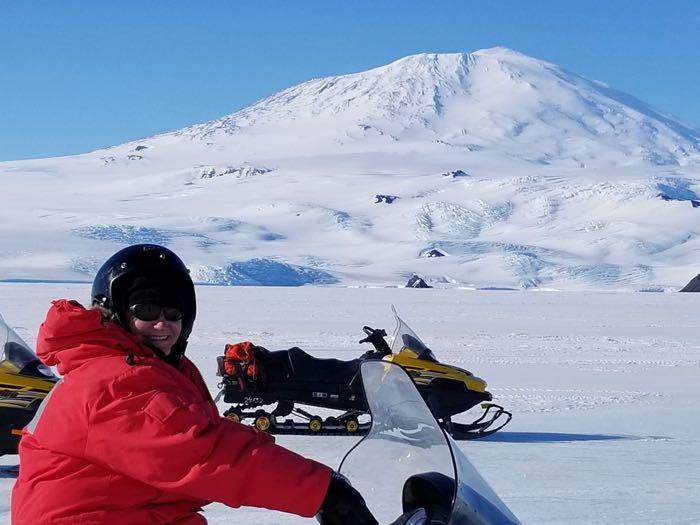 Denise Hardoy riding her Snowmobile to Cape Evans
Denise Hardoy riding her Snowmobile to Cape Evans
We met after brunch...which was amazing prime rib by the way. The day was a sunny but crisp 18 degrees with very little wind. Sunscreen- check, sunglasses- check. We donned our helmets and covered all possible exposed skin. The windchill, even on a warm day, can cause frostbite before you know it. I started up my machine- the motor catching on the first pull. Our caravan of six snowmobiles, two sleds, four survival bags, and everyones Extreme Cold Weather gear bags, pulled out and down the transition road to the sea ice. We called in to McMurdo Operations to let them know our itinerary and expected time of return...and we were off!
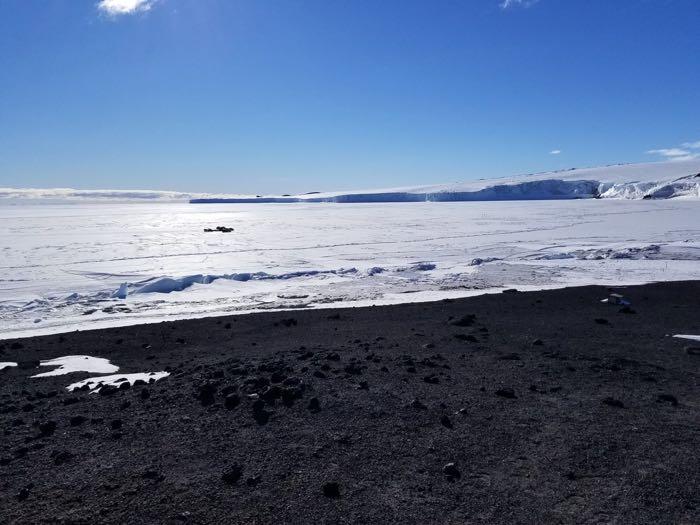 Barne Glacier from Cape Evans
Barne Glacier from Cape Evans
The snow was "flat". That doesn't mean it was smooth, but rather that it appeared flat- you couldn't see the bumps and valleys. The terrain all blended together. Thankfully, we started out slowly, as I wasn't the only beginner.
It took a little while to get the hang of it. I'm used to driving a four-wheeler, but sliding on ice and snow is a little different. The runners tend to catch the previous sleds track and pull you around like the cars on a Disneyland track. I was warned that these machines are a little top heavy, and you could feel it. It kind of felt like it would tip if I hit burms at an awkward angle going very fast. Everyone was OK with taking it slowly until we were all was comfortable.
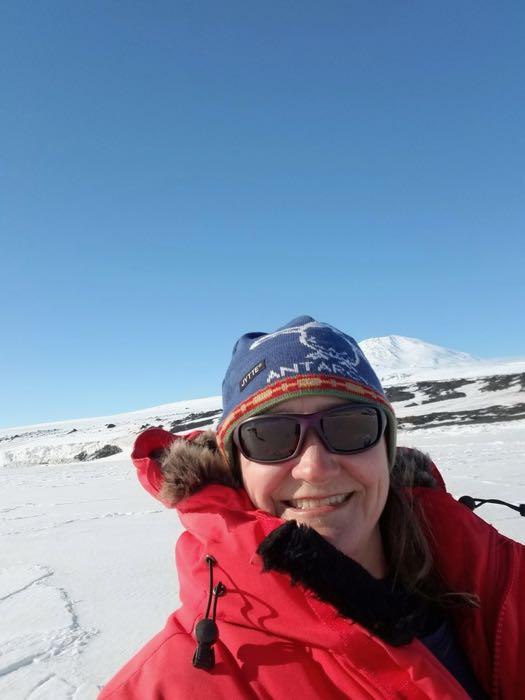 Mt. Erebus Selfie
Mt. Erebus Selfie
We stretched out as we wound our way through the convoluted path leading out to our destination. We needed to follow the windy flagged path to stay on safe ground. There is a whole crew of people that work to make sure the ice is safe and the cracks are monitored. So, instead of going straight there, our route took us on a scenic tour of McMurdo Sound. We had a relatively close view of a Weddell seal that had taken up resting near our road. We were careful to give the seal plenty of space, as you cannot approach any wildlife in Antarctica. I was hoping to see some penguins, but alas, not today. They seem to be elusive this year.
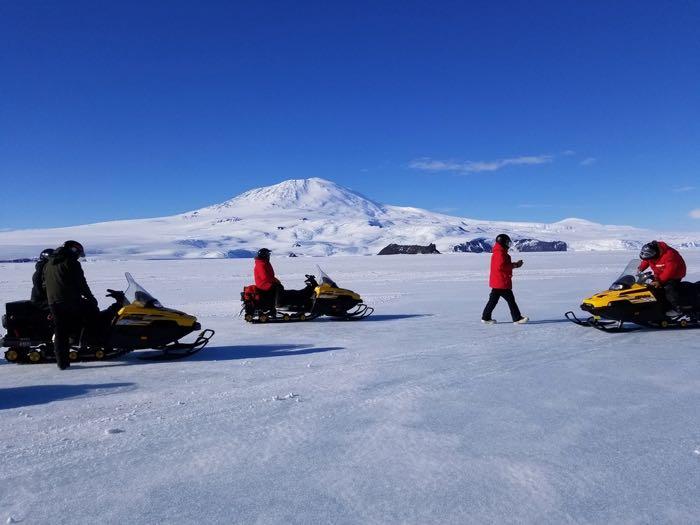 Taking a break in front of Mt. Erebus
Taking a break in front of Mt. Erebus
I was staying pretty warm, but kept fogging up my sunglasses. We hit icy patches, and areas where the snow was piled thick and was getting soft. Then, we found a slushy section with ankle deep water. Everyone got off the machines. The experienced people scoped out the situation and found us a dry way across. It turns out that a melt pond had formed from vehicles getting stuck the days before and turning up the snow. It wasn't a flooding crack, so we were safe to go around.
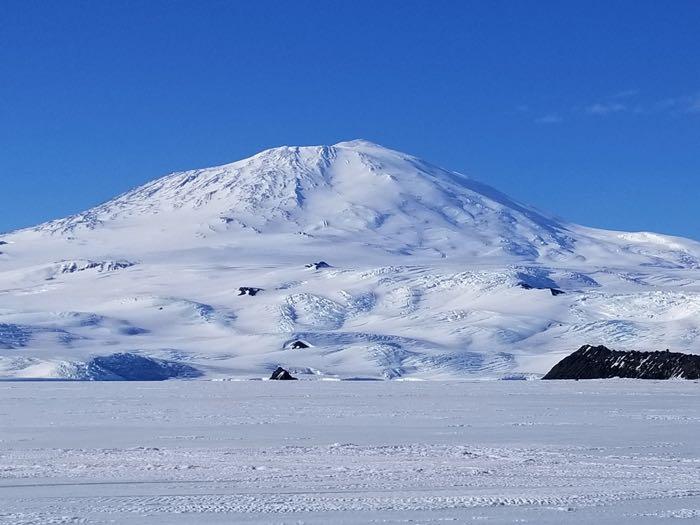 Mt. Erebus shines on a sunny day.
Mt. Erebus shines on a sunny day.
Two hours sped by and we arrived at Cape Evans. We left our snow machines on the sea ice and climbed up the bank to the Terra Nova hut. It was constructed by explorer Robert F. Scott around 1912 on his third expedition in his quest to reach the South Pole. It is still full of all of their supplies and equipment- almost untouched by time. Little deterioration happens when temperatures rarely reach above freezing.
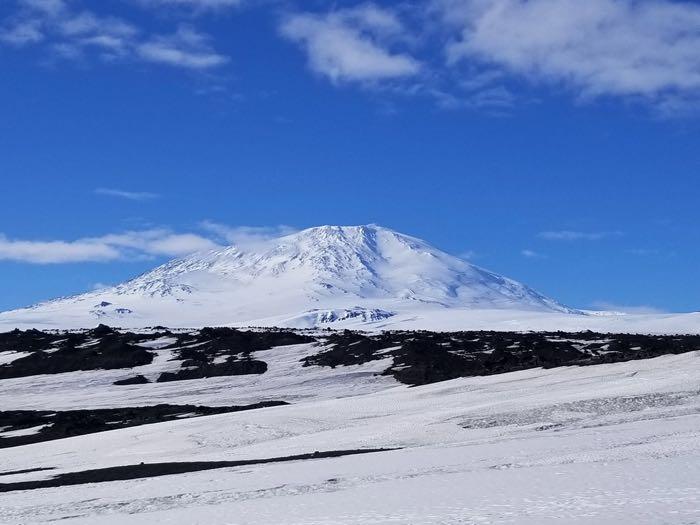 Mt Erebus from Terra Nova Hut
Mt Erebus from Terra Nova Hut
We climbed the hill behind the hut to the cross that was erected in honor of several of his men that perished on the expedition. It is a bump on the lower slopes of Mt. Erebus. Black volcanic rock of every size littered the ground. There was a biting wind at the top that had everyone reaching for their hats and neck gaiters. We were honored when Aaron, a member of the B-307 team studying sea spiders, made a traditional ceremonial Japanese tea for everyone to enjoy. It was warm, delicious and comforting all at once. The end of the tea signaled the time to start heading back.
We wound our way back down the hill to our snowmobiles, stepping carefully over tidal cracks in the sea ice. The machines started right up, and we were on our way. The terrain was so much easier to see on the way home, as the light had changed. As we zipped along, I was more confident, and the bumps and curves made the journey so much fun. I even think I caught a tiny bit of air on one bump, but maybe it was just in my imagination. All too soon we arrived back on base.
Meet our Scientists
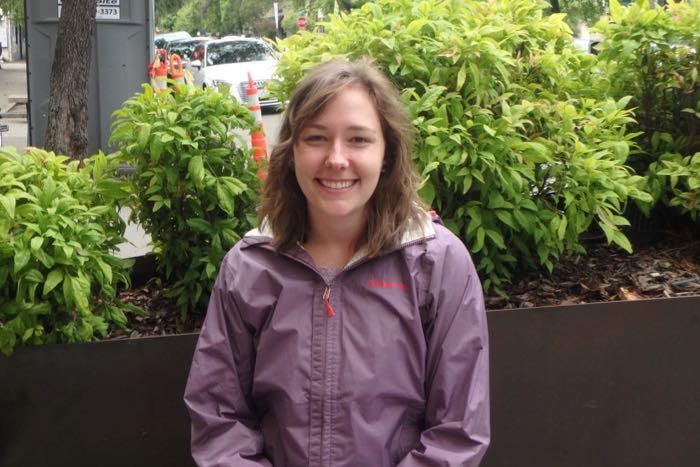 Amanda Frazier, UC. Davis Grad Student
Amanda Frazier, UC. Davis Grad Student
This is B-207's amazing grad student, Amanda Frazier. Dr. Todgham really appreciates all her hard work, saying, "One of the joys of supervising a student is watching them develop into an independent scientist and explore ideas that really spark an interest. This year, Mandy is diving under the sea ice to help collect the fishes we need for our experiments. By watching fish in their natural habitat, Mandy is seeing things we really have not thought about before and she is constantly coming back with questions and hypotheses she wants to test. The excitement she has after a dive for the science we are doing is truly contagious”
I caught up with her a few days ago to ask her a few questions.
- What are your responsibilities in Dr. Todgham's project?
We all share the responsibility of overall maintenance of the experiment (like checking the CO2 system, fish care, and measuring the carbonate chemistry of our treatment water) and then each one of us focuses in on one metric of stress response of fish acclimated to the larger experimental treatments. It’s like each one of us focuses in on one piece of the larger puzzle. My piece of the puzzle is to measure the oxygen consumption of individual fish which we then use to calculate their metabolic rate. The metabolic rate of an animal is important because it basically tells us how much energy they are spending just to live under different conditions. After we get back to Davis, I will process samples, analyze data, run statistics, and write up papers sharing our findings.
- Are you working on your own research as well?
We all have small pet projects that we are working on that complement the objectives in Anne’s grant. I’m really interested in understanding the habitat use of the fish and if they have any preferences for rocky or icy structure.
- What got you interested in science?
I actually never really thought I would go into science until pretty late in my education, maybe because I didn’t actually understand what “being a scientist” means or because I didn’t think I fit in as the stereotypical scientist. My Dad is an engineer, though, and encouraged me to pursue something in STEM in my undergraduate, so I decided to major in Marine Science and Biology mostly because of my interest in the environment. Then while in my undergraduate I took a lot of classes on marine systems and climate change and I became particularly interested in polar biology because of the drastic rate at which the poles are experiencing climate change.
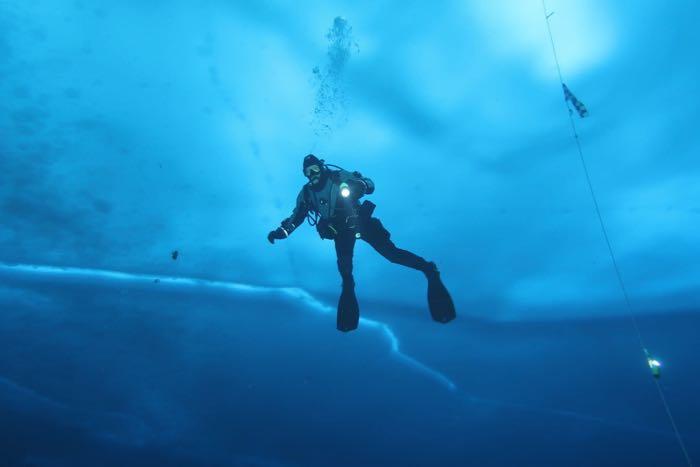 Photo courtesy of USAP diver Steve Rupp
Photo courtesy of USAP diver Steve Rupp
- What are some of your hobbies outside of work?
One of my favorite things to do is to cook together with friends. I’ve been really lucky to find a good community of graduate students in Davis who all value quality time with each other. Apart from that, I also enjoy rock climbing, yoga, reading, and writing.
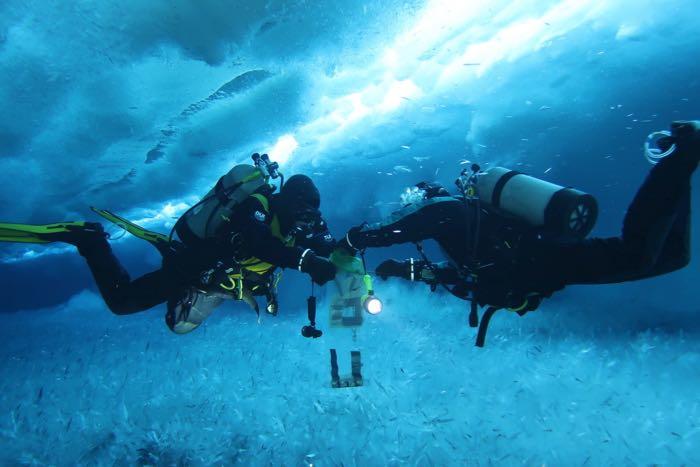 Photo courtesy of USAP diver Steve Rupp
Photo courtesy of USAP diver Steve Rupp
- What is your favorite part of working in Antarctica?
Definitely being able to dive here! The underwater world here is really stunning I feel very lucky to be able to actually see it firsthand. Observation is a really important part of developing research questions and being able to observe our fish underwater in their natural environment has helped me understand the ecosystem in a better way that has led to a lot of new questions.
- Can you tell me about your educational background? Where are you from and what schools you attended. Maybe about how you got started diving as well.
I’m from Colorado originally, but I moved to Miami, Florida to go to the University of Miami for my undergraduate. I went there for the Marine Science program, which is then (somewhat ironically) what led me to polar science. After a research internship at Texas A&M in college, I realized that people actually do polar biology and that it could be a real option for me. So I looked for graduate programs focusing on polar biology and found Anne’s research program and now here I am doing my PhD with Anne.
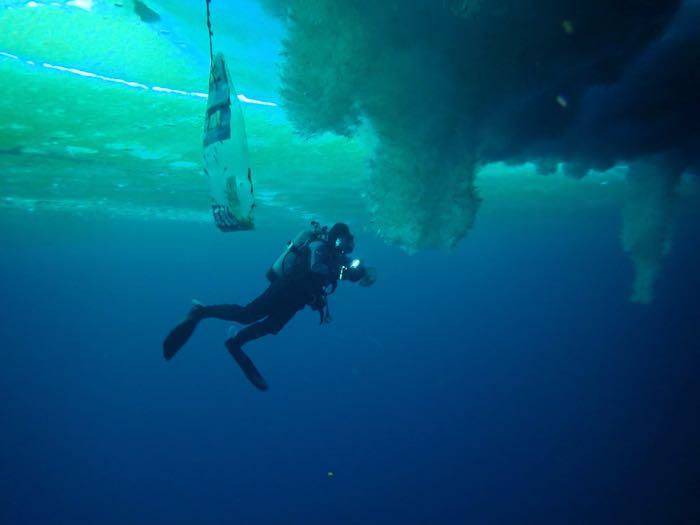 Photo Courtesy of USAP Diver John Heine
Photo Courtesy of USAP Diver John Heine
- What advise do you have for my students who might be thinking of a career in science?
My biggest advice would be that you don’t have to look, act, or feel like the “stereotypical scientist” to be a scientist. In reality, there is a huge diversity of who a scientist is. Embrace your individuality and your interests and try to not force yourself into a mold of what you think you need to be to be a scientist.
- What are your plans for your future?
I have a few different ideas of what I’d like to do with my PhD. One great option would be to go into academia and continuing to research Antarctic ecosystems, but I could also see myself doing some sort of policy or outreach work. I really hope that I can continue working with issues in polar science in some form or another, because I am really fascinated by these ecosystems and by the drastic changes that they’re facing.
Shout Out
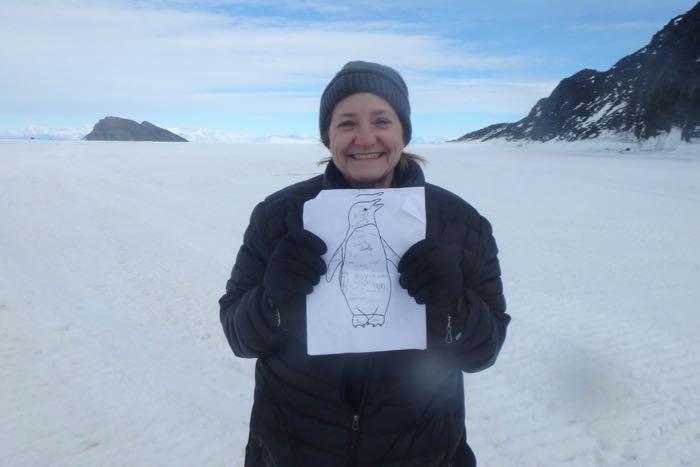 Greenfield School District Penguins
Greenfield School District Penguins
Today's shout out goes to a great bunch of students from Greenfield's Elementary Schools. Thanks for letting me come talk to you before I headed out to Antarctica. Thanks for following my expedition!
Stay Cool,


Comments
Add new comment